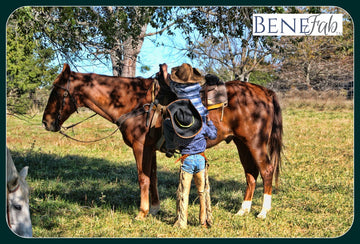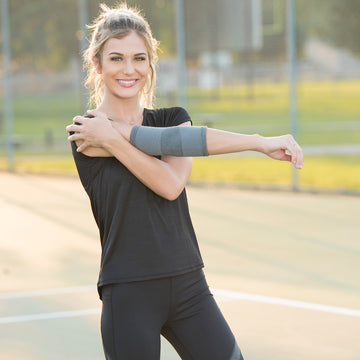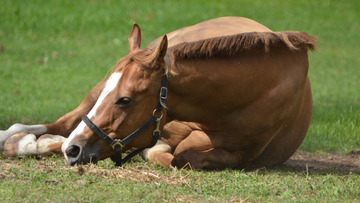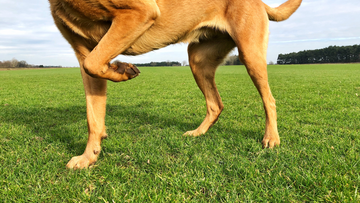 When you are getting ready to ride your horse, you generally have a plan for that ride which consists of what you are going to work on. We tend to examine our ride under a microscope, looking at every single detail and how we can improve ourselves or our horse. Think back, did you pay attention to mounting your horse? This is something that we as riders constantly overlook. When mounting our horse, difficult horses are dealt with right away then we move on with our ride. If your horse is being difficult when mounting, do you know why? Is it behavior or physical? Do you use a mounting block?
Horses are built long-ways and are more stable this way. The easiest way to look at this is that a horse is easier rolled over sideways rather than from end to end. When we mount a horse from the ground, we are pulling on one side of the horse. In order for the horse to compensate for this pull, the horse needs to counteract and must raise their back on the opposite side. The horse is adjusting the base of their support.
During the ground mounting process, the saddle is pulled towards the rider as they mount. The saddle presses against the horse’s spine and withers. The horse will avoid this pressure and move opposite. After time, all of this moving, shifting, and supporting can cause some damaging effects on the horse’s back.
So what is worse? Mounting from the ground or using a mounting block? Well, both do torque your horse’s back in some way, but a mounting block is less strain. When mounting from the ground, the rider is accelerating upwards against gravity and their entire body weight has to be lifted off the ground. The greater distance upwards a person has to go, the more energy is required to lift the person. When mounting from a block, the rider does not have to lift themselves as far up as a person from the ground, which uses less energy.
When using a mounting block, there are some things to be cautious of. If a horse has never been mounted from a block, they might be frightened when they see you throwing a big block beside them. Introduce your horse to the block. Make sure the block is standing on level ground in a clean area. Also, make sure you horse learns the proper manners when using a mounting block so you don’t end up on the ground. Your horse should stand quietly and NOT move until you are ready.
Mounting will eventually cause stress on a horse’s back no matter what. Reduce the amount of stress by using a mounting block or a lift from a friend. Your horse will thank you!
For more information on mounting, visit: http://equusmagazine.com/article/ease_mounting_pressures_021009-8326
When you are getting ready to ride your horse, you generally have a plan for that ride which consists of what you are going to work on. We tend to examine our ride under a microscope, looking at every single detail and how we can improve ourselves or our horse. Think back, did you pay attention to mounting your horse? This is something that we as riders constantly overlook. When mounting our horse, difficult horses are dealt with right away then we move on with our ride. If your horse is being difficult when mounting, do you know why? Is it behavior or physical? Do you use a mounting block?
Horses are built long-ways and are more stable this way. The easiest way to look at this is that a horse is easier rolled over sideways rather than from end to end. When we mount a horse from the ground, we are pulling on one side of the horse. In order for the horse to compensate for this pull, the horse needs to counteract and must raise their back on the opposite side. The horse is adjusting the base of their support.
During the ground mounting process, the saddle is pulled towards the rider as they mount. The saddle presses against the horse’s spine and withers. The horse will avoid this pressure and move opposite. After time, all of this moving, shifting, and supporting can cause some damaging effects on the horse’s back.
So what is worse? Mounting from the ground or using a mounting block? Well, both do torque your horse’s back in some way, but a mounting block is less strain. When mounting from the ground, the rider is accelerating upwards against gravity and their entire body weight has to be lifted off the ground. The greater distance upwards a person has to go, the more energy is required to lift the person. When mounting from a block, the rider does not have to lift themselves as far up as a person from the ground, which uses less energy.
When using a mounting block, there are some things to be cautious of. If a horse has never been mounted from a block, they might be frightened when they see you throwing a big block beside them. Introduce your horse to the block. Make sure the block is standing on level ground in a clean area. Also, make sure you horse learns the proper manners when using a mounting block so you don’t end up on the ground. Your horse should stand quietly and NOT move until you are ready.
Mounting will eventually cause stress on a horse’s back no matter what. Reduce the amount of stress by using a mounting block or a lift from a friend. Your horse will thank you!
For more information on mounting, visit: http://equusmagazine.com/article/ease_mounting_pressures_021009-8326
Blog
Mounting: From the Ground or a Mounting Block?

 When you are getting ready to ride your horse, you generally have a plan for that ride which consists of what you are going to work on. We tend to examine our ride under a microscope, looking at every single detail and how we can improve ourselves or our horse. Think back, did you pay attention to mounting your horse? This is something that we as riders constantly overlook. When mounting our horse, difficult horses are dealt with right away then we move on with our ride. If your horse is being difficult when mounting, do you know why? Is it behavior or physical? Do you use a mounting block?
Horses are built long-ways and are more stable this way. The easiest way to look at this is that a horse is easier rolled over sideways rather than from end to end. When we mount a horse from the ground, we are pulling on one side of the horse. In order for the horse to compensate for this pull, the horse needs to counteract and must raise their back on the opposite side. The horse is adjusting the base of their support.
During the ground mounting process, the saddle is pulled towards the rider as they mount. The saddle presses against the horse’s spine and withers. The horse will avoid this pressure and move opposite. After time, all of this moving, shifting, and supporting can cause some damaging effects on the horse’s back.
So what is worse? Mounting from the ground or using a mounting block? Well, both do torque your horse’s back in some way, but a mounting block is less strain. When mounting from the ground, the rider is accelerating upwards against gravity and their entire body weight has to be lifted off the ground. The greater distance upwards a person has to go, the more energy is required to lift the person. When mounting from a block, the rider does not have to lift themselves as far up as a person from the ground, which uses less energy.
When using a mounting block, there are some things to be cautious of. If a horse has never been mounted from a block, they might be frightened when they see you throwing a big block beside them. Introduce your horse to the block. Make sure the block is standing on level ground in a clean area. Also, make sure you horse learns the proper manners when using a mounting block so you don’t end up on the ground. Your horse should stand quietly and NOT move until you are ready.
Mounting will eventually cause stress on a horse’s back no matter what. Reduce the amount of stress by using a mounting block or a lift from a friend. Your horse will thank you!
For more information on mounting, visit: http://equusmagazine.com/article/ease_mounting_pressures_021009-8326
When you are getting ready to ride your horse, you generally have a plan for that ride which consists of what you are going to work on. We tend to examine our ride under a microscope, looking at every single detail and how we can improve ourselves or our horse. Think back, did you pay attention to mounting your horse? This is something that we as riders constantly overlook. When mounting our horse, difficult horses are dealt with right away then we move on with our ride. If your horse is being difficult when mounting, do you know why? Is it behavior or physical? Do you use a mounting block?
Horses are built long-ways and are more stable this way. The easiest way to look at this is that a horse is easier rolled over sideways rather than from end to end. When we mount a horse from the ground, we are pulling on one side of the horse. In order for the horse to compensate for this pull, the horse needs to counteract and must raise their back on the opposite side. The horse is adjusting the base of their support.
During the ground mounting process, the saddle is pulled towards the rider as they mount. The saddle presses against the horse’s spine and withers. The horse will avoid this pressure and move opposite. After time, all of this moving, shifting, and supporting can cause some damaging effects on the horse’s back.
So what is worse? Mounting from the ground or using a mounting block? Well, both do torque your horse’s back in some way, but a mounting block is less strain. When mounting from the ground, the rider is accelerating upwards against gravity and their entire body weight has to be lifted off the ground. The greater distance upwards a person has to go, the more energy is required to lift the person. When mounting from a block, the rider does not have to lift themselves as far up as a person from the ground, which uses less energy.
When using a mounting block, there are some things to be cautious of. If a horse has never been mounted from a block, they might be frightened when they see you throwing a big block beside them. Introduce your horse to the block. Make sure the block is standing on level ground in a clean area. Also, make sure you horse learns the proper manners when using a mounting block so you don’t end up on the ground. Your horse should stand quietly and NOT move until you are ready.
Mounting will eventually cause stress on a horse’s back no matter what. Reduce the amount of stress by using a mounting block or a lift from a friend. Your horse will thank you!
For more information on mounting, visit: http://equusmagazine.com/article/ease_mounting_pressures_021009-8326





















